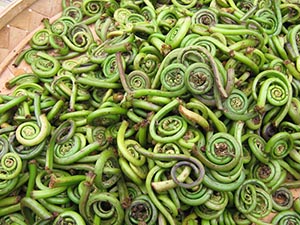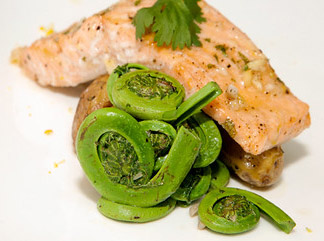Fiddlehead ferns Nutrition facts
Fiddlehead ferns are young, tender, tightly furled new growth shoots of fern family plant, usually of the ostrich fern. The curly shoots are so named after their unique resemblance to the fiddle (violin) head.
The tender fiddlehead fronds are very popular among the inhabitants of Maine, Vermont in the US and New Brunswick provinces in Canada where their brief season in the latter part of spring attracts many food enthusiasts.
Ostrich variety fern belongs to the unique flowerless plant species Onocleaceae, a small family of terrestrial ferns. Scientific name: Matteuccia struthiopteris.
 |
| Fresh fiddlehead fronds. Photo courtesy: GlennFleishman. |
Ostrich ferns are the most common edible fiddle-ferns found in North America. The fern is a clump-forming (like an ostrich plume), deciduous plant, which typically grows in well-drained, moisture-rich shady environments. During the spring, numerous fiddlehead fronds erupt spring-up all along the root (rhizome) spread of the big fern plant.
Their harvesting season is very short and should be done before the fronds unfurl.
Each fiddlehead is a tightly curled, deep green stalk measuring about 4 cm in diameter, reaching the height of about 10-12 cm off the ground. Its tender shoots are covered with brown scales that are scraped off before use in cooking. Young and tender fronds taste similar to that of asparagus, or green beans with a crunchy texture of their own.
Vegetable fern (Diplazium esculentum), known locally as lungru, are found in the foothills of North India and Nepal and eaten as a local delicacy. Lungru season lasts very briefly from May until June.
Health benefits of Fiddlehead ferns
Fiddlehead ferns are unique in their appearance, taste, and nutrition profile. The curly young shoots carry just 34 calories per 100 g. Nonetheless, their high-quality plant-nutrition profile consists of health-benefiting antioxidants, vitamins, and omega-3, and omega-6 essential fatty acids.
Fresh fronds are very high in antioxidant vitamin-A and carotenes. 100 g of fiddleheads hold 3617 IU of or 120% of recommended daily requirements of vitamin-A. Vitamin A is a powerful natural antioxidant and is required by the body for maintaining the integrity of skin and mucosa. It is also an essential vitamin for vision. Research studies suggest that natural foods rich in vitamin A help the human body protect against lung and oral cavity cancers.
They are an excellent source of many natural polyphenolic flavonoid compounds such as α and ß-carotenes. Carotenes convert into vitamin A inside the body.
Their unique sweet taste comes from their richness in vitamin C. 100 g of fresh fronds contains 26.6 mg or 44% of the daily required levels. Vitamin C is a moderately potential water-soluble anti-oxidant. Together with flavonoid compounds like carotenes, it helps scavenge harmful free radicals and offers protection from cancers, inflammation, and viral cough and cold.
Fern shoots are a very good source of minerals and electrolytes, especially potassium, iron, manganese, and copper. 100 g of fresh sprouts carry 370 mg or 7% of the daily required levels of potassium. Potassium is a heart-friendly electrolyte, which helps reduce blood pressure and heart rate by countering sodium effects.
Further, they contain small to moderate levels of some of the valuable B-complex group of vitamins such as niacin, riboflavin, and thiamin.
| Principle | Nutrient Value | Percent of RDA |
|---|---|---|
| Energy | 34 Kcal | 1.7% |
| Carbohydrates | 5.54 g | 4% |
| Protein | 4.55 g | 8% |
| Total Fat | 0.40 g | 2% |
| Cholesterol | 0 mg | 0% |
| Vitamins | ||
| Niacin | 4.980 mg | 31% |
| Riboflavin | 0.210 mg | 16% |
| Thiamin | 0.020 mg | 1.5% |
| Vitamin A | 3617 IU | 120.5% |
| Vitamin C | 26.6 mg | 44% |
| Electrolytes | ||
| Sodium | 1 mg | <1% |
| Potassium | 370 mg | 8% |
| Minerals | ||
| Calcium | 32 mg | 3% |
| Copper | 0.320 mg | 35.5% |
| Iron | 1.31 mg | 16% |
| Magnesium | 34 mg | 8.5% |
| Manganese | 0.510 mg | 22% |
| Selenium | 0.7 mcg | 1% |
| Zinc | 0.83 mg | 7.5% |
| Phyto-nutrients | ||
| Carotene-ß | 2040 µg | -- |
| Carotene-alpha | 261µg | -- |
Selection and storage
Fresh fiddlehead ferns are available in the selective farmer markets from late March to June. While choosing fiddleheads look for deep or bright green, firm, tightly coiled ferns. Do not buy unfurled and bigger ferns as they are tough and unappetizing. The scales are bitter and need to be removed before being used in cooking.
Fiddlehead ferns should be used as they are fresh, otherwise, store them wrapped in plastic paper and place them in the refrigerator set at high relative humidity where they stay fresh for 2-3 days.
Preparation and serving methods
Before cooking, remove any brown outer scales using a brush or cloth. Trim away the stem ends up to the base of the coiled crozier. Wash them in cold water thoroughly. They are then boiled in salted water for 1-2 minutes. Drain and discard the water. The process may be repeated two to three times to remove their bitterness. Ostrich ferns are the only proven varieties free from any cancer-causing bitter compounds and are generally recommended varieties in North America.
Fresh ferns are sought after in many parts of the American world. They employed recipes in a similar way like asparagus or green beans, to prepare a perfect side dish.
Here are some serving tips:
 |
| Fiddlehead ferns and salmon recipe. Photo courtesy: SodexoUSA |
Cooked ferns acquire a chewy texture. Fresh ferns, in general, are treated just like asparagus in cooking. Overcooking makes them soft and mushy. They can be steamed, sautéed, stir-fried, or mixed with vegetables, beans, or seafood. Crispy pan-seared salmon recipe with fiddlehead fronds is a specialty dish in Boston restaurants.
They served crisp tossed with melted butter and seasoned with salt and pepper.
In the Himalayan region of India, a different variety of vegetable fern is found at high altitudes, famous locally as lungru. The young tender fronds are eaten in salads, stews, stir-fries, and used to prepare pickles.
Safety profile
Not all types of fiddlehead ferns available in the woods are suitable for human consumption. Prolonged use of the wild variety fern fronds has been found to cause stomach and esophagus cancers. Bracken fern (Pteridium aquilinum) species may be associated with higher incidences of these diseases.
Only ostrich fern is free from toxic cancer-causing compounds. Several different ferns grow in the woods feature a similar appearance and give rise to new beginnings at the same time. Only expert native harvesters could identify safe and edible ostrich ferns in the woods. Confirm from the local farmers about the right kind of ferns before eating. (Medical disclaimer).
≻≻-Back to Vegetables from Fiddlehead ferns. Visit here for an impressive list of vegetables with complete illustrations of their nutrition facts and health benefits.
≻≻-Back to Home page.
Further resources:
Alaska plant profiles- Fiddlehead ferns-pdf.